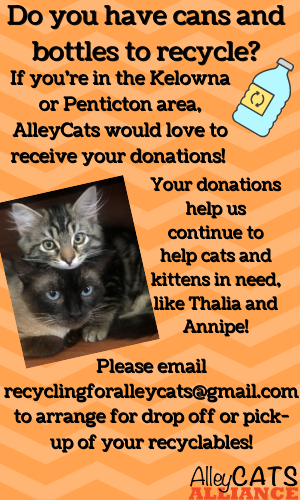Bottle Feeding 101
If the kitten refuses to take the nipple or won’t suckle
try rubbing its forehead vigorously or stroking its back. This is the way the mom cat cleans the baby and can stimulate the kitten to nurse. You might hear a “clicking” sound which means the kitten’s nursing instinct is in gear and it should be ready for the nipple. Sometimes a kitten is just picky and doesn’t like the nipple you are offering. Your bottle kit should come with different size nipples, one longer than the other. See if the kitten likes the other nipple better.
Kittens too weak to nurse
can often be stimulated by rubbing some Karo syrup on the lips. If the kitten still refuses to nurse despite everything you have tried, the kitten may be ill and you must take it to a vet immediately.
A kitten should consume about 8cc’s of formula per ounce of body weight per day
Nursing bottles are marked with measurements to help keep track. Weigh the kittens at least every other day to calculate the amount of formula they need. A small postal scale should be sufficient. Kittens under one week: feed every 2-3 hours. At 2 weeks old: feed every 4-6 hours. At 3 weeks until they are weaned: feed every 6-8 hours. Divide their needed daily intake by the number of required daily feedings and you’ll know how much they should eat each time. Weak or recovering kittens may need to eat more frequently. The younger the kittens are, the more they want to “latch” on to a mom cat’s nipple all the time, nursing small amounts periodically. If you notice that your kittens are not eating enough in one feeding, increase the frequency of feedings.
If you are feeding multiple kittens
it might be easier to feed the required amount if you feed them each several times, taking turns. Feed the first kitten until it stops nursing, and then feed the second, etc. Then go back to the first and repeat the rotation. Usually, after 2-3 nursing turns, a kitten has had enough for one
feeding.
When the kitten has had enough formula
it will usually get some bubbles around its mouth and its tummy
will be very rounded. After feeding, burp the kitten just like a human baby. Hold it upright against your shoulder and pat it on the back.
Do not overfeed kittens
This can cause diarrhoea and a host of other problems. Kittens under four weeks should go to sleep after they are fed and full. Older kittens will want some play and cuddle time.
It is natural for kittens to suckle on each other or on your fingers
even after they have finished eating. This is harmless unless you notice that this kind of activity is causing irritation to other kittens’ fur or skin.
Emergency Kitten Formula Recipes
You have just rescued baby kittens and the pet store is closed. They are hungry. What to do!!! The formulas listed below are for emergency use only until regular kitten formula (such as KMR or Just Born) can be purchased from the pet store. None of these formulas are nutritionally complete enough for the long-term health of a kitten.
Formula #1
8 ounces homogenized whole milk
2 egg yolks
1 tsp salad oil
1 drop liquid pediatric vitamins (optional)
Mix well. Warm before using. Keep refrigerated.
Formula #2
12 oz. evaporated goats milk
12 oz water
Knox unflavored gelatin. (One packet for each week of kitten’s age but no more than 4 packets.)
Only add more if diarrhoea occurs.
Heat on stove until dissolved.
Add 1 Tbsp Karo Syrup
Add 1 Tbsp nonfat or low-fat unflavored yoghurt
Add 1 Tbsp protein powder
Add 1 Drop PetTinic Vitamins
Mix all ingredients well. Refrigerate. It becomes like Jell-O. Cut the amount needed for each feeding and heat in the microwave. Keeps up to one week.
Formula #3
1 envelope unflavored gelatin
Water per directions on gelatin envelope
1 12-oz can whole evaporated milk (not skimmed)
3 Tbsp plain yoghurt (not low-fat)
3 tsp clear corn syrup
3 Tbsp mayonnaise
1 or 2 raw egg
yolks (no egg white)
Boil water. Add gelatin powder. Add the other ingredients in the following order, mix well after each addition: half the canned milk, corn syrup, mayonnaise + yoghurt, egg yolk, the remainder of canned milk. Serve room temperature or slightly warmed. DO NOT reuse uneaten portions. The mixture turns into jelly when refrigerated. Keeps covered up to 2 weeks. Spoon out what you need to use. Warm before feeding.


